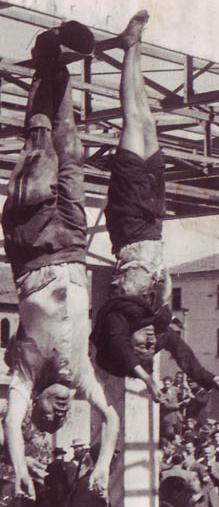Modesty and Killing November 27, 2012
Author: Beach Combing | in : Ancient, Contemporary, Medieval, Modern , trackbackWhen Benito Mussolini was ‘executed’ (jolted out of a car by some communist partisans and shot in the chest in a ditch) he did not die alone. By his side was his lover and perhaps the most significant woman in his life, Clara Petacci. CP was gunned down a moment before Mussolini himself. The corpses were driven down to Milan (unpleasant picture warning) and the two bodies were famously hung upside down with thirteen other Fascist ‘greats’, before a garage in Milan’s Piazzale Loreto and there they were beaten and pelted with fruit in an act that would do no nation credit but that was particularly out of character for Italy. Edda Mussolini, the best of her family, memorably called it ‘Italy’s last act of love for Mussolini’. However, even this post-death, extra-judicial execution ran into some problems. Clara Petacci had been forced very rapidly out of bed that morning by the partisans and had not had time to put on her underwear. In fact when she was pushed into the car for her last murderous journey she had on only a skirt and shirt. The result was that as soon as she was hung upside down, she was exposed to the crowd. The good Catholic Milanese working their anger on the dead, immediately stopped for Clara to be put right (her skirt was pinned to her legs) and then began over…
This strange combination of viciousness and prudery is not new, particularly where women are concerned. There is one documented case of a Roman crowd becoming furious when a Christian victim was sent out naked to be tossed by oxen (in Carthage?): the games were momentarily stopped clothes were placed back on the poor woman and another animal was brought out to kill her. Even the form of execution was decided in medieval centuries by the concern over how much of a woman would be seen. For example, hanging was bad because it would allow shameful glimpses to a crowd in an age where women universally wore skirts and very often did not have underwear. Burning was also dangerous in this respect, because clothes could be burnt off the witch or the scold before the body was properly incinerated: there are some striking examples of this in accounts of Joan of Arc’s all too unpleasant death. The medieval French solution to this was to bury women alive, which marks an extraordinary unpleasant death – though compared with the stake… – all so any idiots who’d turned up wouldn’t have to see breasts or pubic hair. Is this perhaps linked to the supposed ‘erotics’ of execution. drbeachcombing AT yahoo DOT com A depressing and dubious idea.
***
Lehmansterms writes: You’re probably well aware of this – but in the event that it’s better known by those of us raised and educated this side of the pond, I wanted to let you know that this blog entry and the questions of propriety, morbid fascination and the eternally paradoxical relationship between the stated Victorian mindset and the actual behavior of those who claimed to live by these standards, brings to mind the hanging of Mary Surat. The first (white) woman officially executed by the United States(how many women of color may have been unofficially lynched prior to that time is, of course, unrecorded). Implicated for providing a location for the villainy of planning in the conspiracy to assassinate Abraham Lincoln as the owner of the Washington D.C. boarding house near Ford’s Theater in which the plot was mainly hatched, she was swept up in the public cry for revenge and attendant blood-rage which followed the event and was hung semi-publicly on a hot and muggy July day along with 3 men who were unequivocally John Wilkes Booth’s co-conspirators. The event was fully covered by the newspaper reporters of the time – recorded by Matthew Brady’s photographic studio as well – and widely written about in the memoirs of those in attendance. Probably more words were expended in describing in excruciatingly intimate details the last minutes of Mary Surat’s life than those of all of the other principal players combined. At this time it seems she had taken leave of any rational thought, merely babbling on repeatedly requesting of those around her “Please don’t let me fall.” There was some speculation as to whether she meant from the relatively high scaffold erected for the occasion or “the last drop”, as they say – or indeed whether in her mental state she even grasped the situation at all. Many words have been expended on how the executioner’s fingers had tired from tying the nooses for the 3 men, making each with the usual 13 turns of rope in a classic hangman’s knot, and therefore made Mary Surat’s noose (which is probably in the Smithsonian Institution) with only 7 or 8 turns. Great detail also goes into the descriptions of the pause in the proceedings occasioned by what was possibly a near afterthought to tie her dress around her ankles. Of course this was meant to prevent the spectacle’s potential for inadvertently satisfying any covert or overt prurient interest. This, as you note, seems a bit odd to us at our remove from the social mores of the moment when considered within the context of the process of creating an official public spectacle out of her execution, one certainly meant and designed to satisfy the overt morbid interest and rage of the populace.’ Then DM I suppose it is ‘coincidence’ but just today I head most of this interview with author Hilary Mantel where it was remarked that ladies that were to be beheaded were to be advised to tuck their skirts under their knees so when the swordsman lopped off their heads they would not expose themselves, only to find that the ladies, probably through talking it over amongst themselves, had already had already planned to do just that.’ thanks Lehmansterms and DM!




